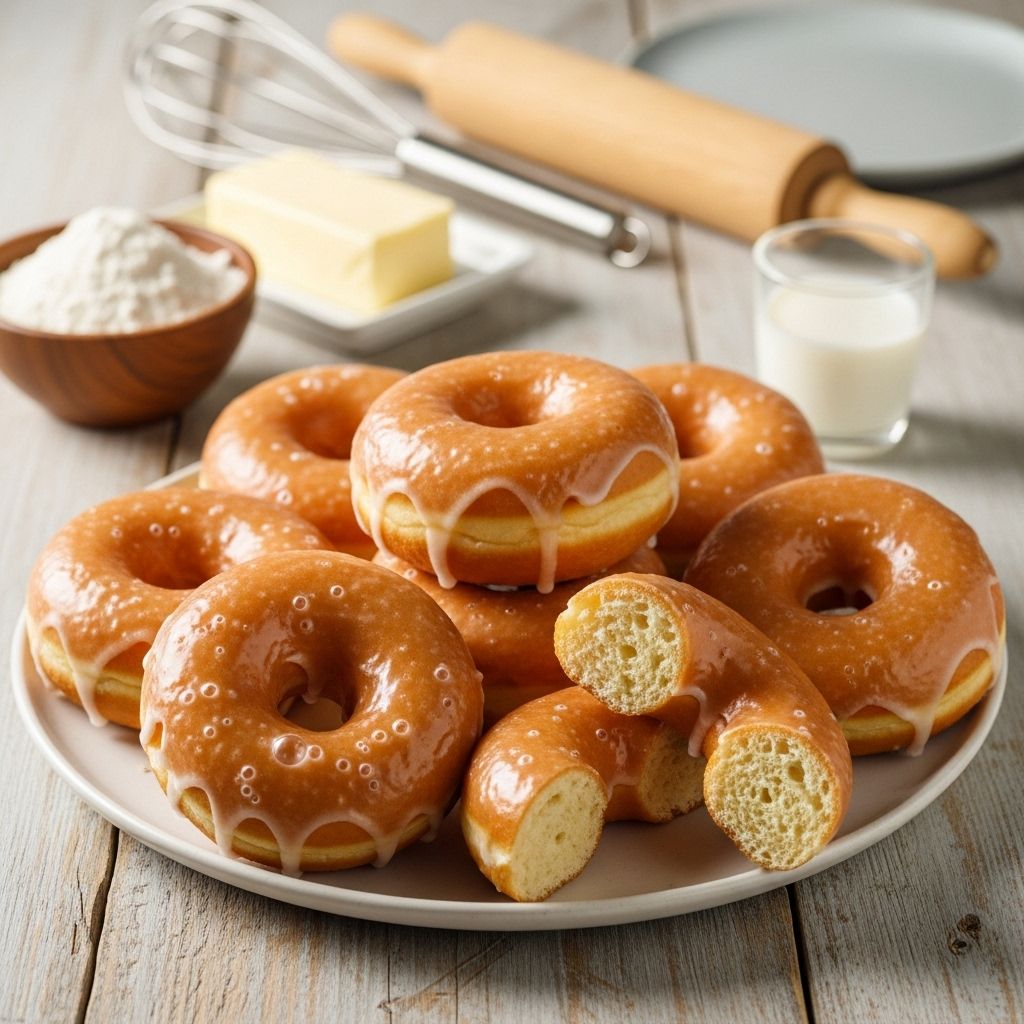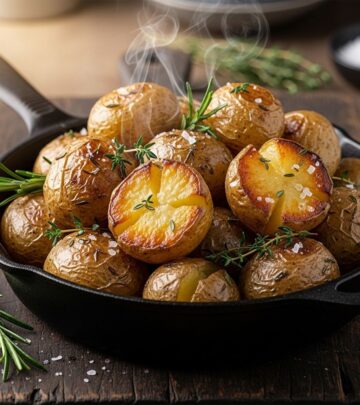Homemade Glazed Donuts: Easy Step-By-Step Recipe
Master the art of creating perfectly soft, pillowy donuts with a sweet, glossy glaze that melts in your mouth

Image: HearthJunction Design Team
Classic Glazed Donuts: A Homemade Delight
There’s something truly magical about biting into a freshly made glazed donut. The soft, pillowy texture of the fried dough paired with that sweet, melty glaze creates an experience that’s hard to beat. While many people assume that making donuts at home is complicated, this recipe will guide you through the process step by step, resulting in donuts that rival those from your favorite bakery.
These classic glazed donuts are perfect for weekend breakfast treats, special occasions, or anytime you’re craving something deliciously sweet. The dough is enriched with eggs and butter, giving it a tender crumb, while the simple glaze adds the perfect finishing touch of sweetness. Let’s dive into how to create these delectable treats in your own kitchen.
Ingredients
For the Donut Dough:
- 1 cup (240ml) whole milk, warmed to about 110°F (43°C)
- 2 and 1/4 teaspoons (7g) instant or active dry yeast (1 standard packet)
- 1/3 cup (65g) granulated sugar, divided
- 2 large eggs
- 6 Tablespoons (85g) unsalted butter, melted and slightly cooled
- 1 teaspoon pure vanilla extract
- 1/4 teaspoon ground nutmeg
- 1/2 teaspoon salt
- 4 cups (500g) all-purpose flour (spooned & leveled), plus more as needed
- 1–2 quarts vegetable oil for frying
For the Glaze:
- 2 cups (240g) confectioners’ sugar, sifted
- 1/3 cup (80ml) heavy cream, half-and-half, or whole milk
- 1/2 teaspoon pure vanilla extract
- Pinch of salt (optional, but adds depth to the flavor)
Equipment Needed
- Stand mixer with dough hook (or large mixing bowl if mixing by hand)
- Rolling pin
- 3-inch and 1-inch round cookie cutters (for donut shapes)
- Deep, heavy-bottomed pot or Dutch oven for frying
- Candy/deep-fry thermometer
- Slotted spoon or spider strainer
- Paper towels
- Cooling rack
- Mixing bowls
Instructions
Preparing the Dough
1. Activate the yeast: In the bowl of your stand mixer, whisk together the warm milk (110°F/43°C), yeast, and 1 tablespoon of the sugar. Cover loosely with a kitchen towel and let it sit for 5-10 minutes until foamy. This step confirms your yeast is active and ready to work.
2. Add wet ingredients: Once the yeast mixture is foamy, add the remaining sugar, eggs, melted butter, and vanilla extract. Mix on low speed until combined.
3. Add dry ingredients: Add the nutmeg, salt, and 2 cups of flour. Mix on low speed until combined. Gradually add the remaining 2 cups of flour, mixing after each addition. The dough should be soft and slightly sticky.
4. Knead the dough: Increase the mixer speed to medium and knead the dough for about 5 minutes until it becomes smooth and elastic. If the dough is too sticky, add more flour, 1 tablespoon at a time. The dough should pull away from the sides of the bowl but may still stick to the bottom.
5. First rise: Transfer the dough to a lightly greased large bowl. Cover with plastic wrap or a clean kitchen towel and let it rise in a warm place until doubled in size, about 1-2 hours.
Shaping the Donuts
6. Roll out the dough: Once the dough has doubled in size, punch it down to release the air. Transfer the dough to a lightly floured surface and roll it out to about 1/2-inch thickness.
7. Cut out donuts: Using a 3-inch round cookie cutter, cut out circles from the dough. Then, use a 1-inch round cookie cutter to cut out the center holes. Place the donuts and donut holes on parchment paper-lined baking sheets.
8. Second rise: Cover the donuts loosely with kitchen towels and let them rise again for about 30-45 minutes, until they appear puffy.
Frying the Donuts
9. Heat the oil: When the donuts are almost done with their second rise, begin heating the oil. Pour the vegetable oil into a large, heavy-bottomed pot or Dutch oven to a depth of about 2-3 inches. Heat the oil to 350°F (175°C). It’s very important to maintain this temperature throughout the frying process, so use a candy/deep-fry thermometer to monitor it.
10. Fry the donuts: Carefully lower 2-3 donuts into the hot oil using a slotted spoon or spider strainer. Fry for about 1-2 minutes per side until golden brown. Be careful not to overcrowd the pot, as this will lower the oil temperature and result in greasy donuts.
11. Drain: Remove the donuts with a slotted spoon and place them on paper towels to drain excess oil. Repeat with the remaining donuts and donut holes, adjusting the heat as needed to maintain the oil temperature.
Making the Glaze
12. Prepare the glaze: While the donuts are cooling slightly, make the glaze. In a medium bowl, whisk together the sifted confectioners’ sugar, cream or milk, vanilla extract, and a pinch of salt (if using) until smooth. The glaze should be thick but pourable. If it’s too thick, add a little more milk; if it’s too thin, add more confectioners’ sugar.
Glazing the Donuts
13. Glaze each donut: When the donuts are still warm but not hot (after about 5 minutes of cooling), dip the top half of each donut into the glaze, allowing any excess to drip back into the bowl. Place the glazed donuts on a cooling rack set over a baking sheet (to catch any drips).
14. Let the glaze set: Allow the glaze to set for about 10-15 minutes before serving. For an extra-thick glaze coating, you can dip the donuts a second time after the first layer has set slightly.
Tips for Perfect Glazed Donuts
- Temperature matters: Make sure your milk is warm (not hot) when activating the yeast. Too hot, and you’ll kill the yeast; too cool, and it won’t activate properly.
- Oil temperature is crucial: Maintain the oil at 350°F (175°C) throughout the frying process. Too hot, and the donuts will brown too quickly without cooking inside; too cool, and they’ll absorb too much oil and become greasy.
- Don’t overcrowd the fryer: Fry only 2-3 donuts at a time to maintain the oil temperature and give the donuts enough space to float and expand.
- Glaze while warm: The donuts should be warm (but not hot) when dipped in the glaze so that it adheres properly and creates that classic shiny finish.
- Storage: Donuts are best enjoyed fresh on the day they’re made. If you need to store them, place in an airtight container at room temperature for 1-2 days. Briefly microwave (10-15 seconds) before eating to restore that fresh-made texture.
Variations
While classic glazed donuts are delicious on their own, you can easily customize this recipe to create different flavors:
- Chocolate glaze: Add 2-3 tablespoons of cocoa powder to the glaze.
- Maple glaze: Replace the vanilla extract with maple extract or add 2 tablespoons of pure maple syrup to the glaze.
- Cinnamon sugar: Instead of glazing, toss warm donuts in a mixture of granulated sugar and ground cinnamon.
- Sprinkles: Add colorful sprinkles on top of the glazed donuts before the glaze sets for a festive touch.
- Filled donuts: Skip cutting out the center holes and use the rounds to make filled donuts. Once fried and cooled, fill with jam, pastry cream, or Nutella using a piping bag fitted with a long tip.
Nutritional Information
Per glazed donut (approximate values):
| Nutrient | Amount |
|---|---|
| Calories | 280-320 |
| Fat | 12-15g |
| Carbohydrates | 40-45g |
| Sugar | 18-22g |
| Protein | 4-5g |
Note: Nutritional values will vary depending on the exact size of your donuts and how much glaze is applied.
Frequently Asked Questions
Q: Can I make the dough ahead of time?
A: Yes! You can prepare the dough and let it have its first rise, then cover it tightly and refrigerate overnight. The next day, let the dough come to room temperature before rolling out and proceeding with the recipe.
Q: Can I bake these donuts instead of frying them?
A: While this recipe is designed for frying, you can bake them at 350°F (175°C) for about 15-18 minutes. However, the texture will be different – more like a sweet roll than a traditional donut.
Q: Why did my donuts turn out dense instead of light and fluffy?
A: This could be due to several reasons: over-kneading the dough, not allowing enough rise time, or frying at too low a temperature. Make sure to follow the rising times closely and maintain the correct oil temperature.
Q: Can I use a different type of oil for frying?
A: Vegetable oil is recommended for its neutral flavor and high smoke point, but canola oil or peanut oil work well too. Avoid oils with strong flavors like olive oil.
Q: How can I tell if my donuts are cooked through?
A: Properly fried donuts should be golden brown on the outside and fully cooked inside. If you’re unsure, you can cut one open to check – the interior should be light, fluffy, and not doughy.
Creating homemade glazed donuts might seem intimidating at first, but with practice, you’ll be making bakery-quality treats that will impress family and friends. There’s nothing quite like the satisfaction of biting into a warm, fresh donut that you’ve made yourself. Enjoy the process and the delicious results!
References
- https://www.youtube.com/watch?v=tojsUHxmOrQ
- https://sallysbakingaddiction.com/how-to-make-homemade-glazed-doughnuts/
- https://hotchocolatehits.com/2020/05/classic-glazed-doughnut-recipe.html/
- https://www.thepioneerwoman.com/food-cooking/recipes/a9896/homemade-glazed-doughnuts/
- https://www.youtube.com/watch?v=w6TxH8ha8XU
Read full bio of medha deb












